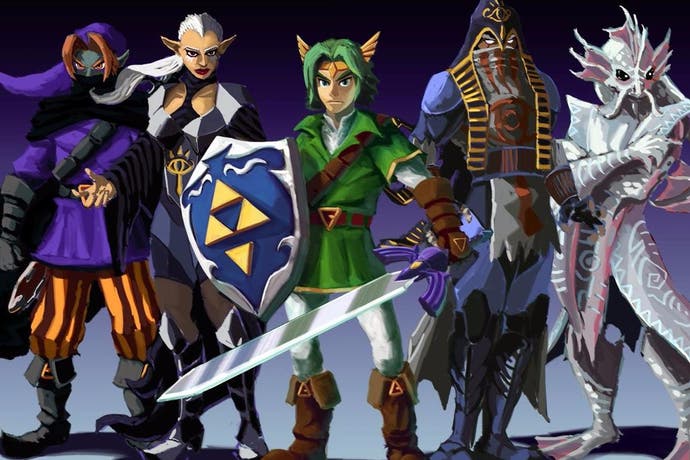Reviving Ocarina of Time's long-lost Ura expansion
Meet the Zelda 64 modders who turned back the clock.
The Legend of Zelda series has always dabbled in alternate realities - mirror worlds, sunken pasts, waking dreams, futures that might have been. This is the story of one such lost future, a dream originally dreamt by the developers of The Legend of Zelda: Ocarina of Time, kept alive by a fervent underground community of fans, modders and artists. It's the tale of a version of Ocarina of Time which is, somehow, both a tangible fact and an eternally deferred Holy Grail, always quested for, never quite grasped - the reworked "Ura" edition that was once planned for release alongside the Nintendo 64's ill-fated 64DD peripheral, tantalising elements of which can still be uncovered on a Zelda 64 cartridge today.
For its age, the 64DD was a fairly magical piece of kit, armed with internet connectivity backed up by a rudimentary gaming network, a real-time clock and support for rewriteable 64MB magnetic discs. Besides giving developers vastly more storage to play with at a fraction of the cost of the N64's existing cartridge format, it would have allowed players to craft their own textures, characters and levels into games like F-Zero and share them over the internet - years before “user-generated content” became an industry buzzword.
For a while, the 64DD was Nintendo's favourite son: in a December 1997 interview, Shigeru Miyamoto claimed that “almost every” new N64 game in production was designed to make use of it. But the add-on was a troubled project from inception, pegged for a 1996 launch only to wallow in development hell till 1999, when it saw a limited release in Japan as part of a game subscription package. By the time the 64DD was fit for public consumption Nintendo was eager to be rid of it, and the combination of an eye-watering price and N64's relatively modest installed base led to an early retirement in February 2001.

As with expensive failures in general, the 64DD casts a long shadow. Many of the games that were built for it found a new lease of life elsewhere - a quirky persistent world simulator known as Animal Forest eventually became Animal Crossing, while a creature breeding game called Cabbage supplied concepts for the best-selling Nintendogs on the DS. As for Ura Zelda, the boring account is that elements of the cancelled add-on were ultimately cobbled together into a secondary "Master Quest" for a 2002 Ocarina of Time remaster on the Gamecube, offering the same gameplay and areas as the vanilla game but with tougher, remixed dungeon layouts.
You can try Master Quest out today on the 3DS, and as far as Nintendo is concerned that's pretty much the end of the story. But if there's one thing Zelda's perpetually rewritten fable of boy heroes, princesses and demon kings is proof of, it's that great stories never end.
"There's a myth behind Ura Zelda, based on interviews with Shigeru Miyamoto and Eiji Aonuma back in the 90s, that it would have been an expansion to Ocarina of Time, adding new dungeons, new overworld areas, new bosses, new everything." Artist and game designer Benjamin Walton is one of the members of Project Ura, a concerted attempt to revive and build on Zelda 64's lost add-on which ran from 2010 to 2013. We're speaking over Skype at one in the morning UK time; also on the call is fellow Ura contributor CrookedPoe, a recent high school graduate from the midwestern United States, who has been modding Zelda games since he was nine years old.
"It's theorised that there would have been an ice dungeon, probably an ice temple, a wind dungeon, probably a wind temple, and who knows what else," Walton continues. "But it really all falls into the realm of speculation, because there is no true confirmation. Now, the speculation also stems from some of the beta elements that were intended for Ocarina of Time, that were left over in the game. For instance, we ended up with the forest temple and the water temple, but in Ganon's tower the forest corridor and the water corridor were wind and ice-themed."

"Not to mention the forest and water medallions look like a fan and a snowflake," CrookedPoe chimes in. "Exactly," Walton continues. "So it's implied that there wasn't originally a water temple or a forest temple per se - instead, there were wind and ice temples and they changed it. It's also possibly implied that elements of what would have been Hyrule Castle became the forest temple, hence why some of the architecture is synonymous with the architecture seen in and around the Hyrule Castle courtyards.
"So the Ura Project was basically this imaginative translation, or re-imagining, of the myth that was the original Ura Zelda, having no evidence whatsoever to prove what it was actually intended to be. And since then, the developers have come out and said - I think it was Miyamoto himself, who straight up said that Ura Zelda just became Master Quest. They basically designed a lot of new puzzles, and instead of making new dungeons to exhibit them they integrated the puzzles into the existing dungeons, in an effort to create a new experience within the same game world."
Over the 18 years since its release, Ocarina of Time's files have been exported to PC and prised apart by generations of enthusiasts, the game's innards poured over for secrets about the wider universe. In the process, Zelda modders have amassed a fearsome body of design and programming lore. They've also set in motion a number of false rumours about cancelled material, often with the best of intentions. "Some of the bigger arguments people have over beta content in Zelda are the so-called three extra tunics, the black, yellow and white one you probably saw while reading around," says CrookedPoe. "That's actually not intended to be a tunic - it's just extra code that's used for setting up Link's torso area in-game."
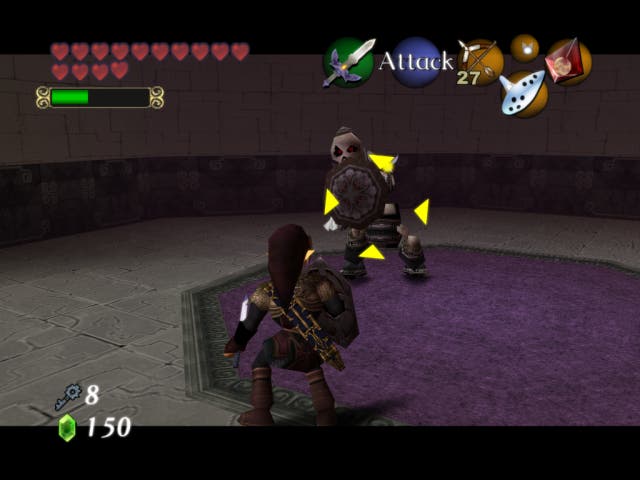
All this naturally reflects the adoration players in general feel for Ocarina of Time - Zelda's first 3D outing, and a pioneering work of environment design. "Any time a single detail slips through the cracks, you can bet it'll turn into an internet sensation and people will obsess over it for years," says Walton. "And that's an example amongst many others of the kind of hazard that arises, because people want to have fun! They want to have fun speculating about what could have been.
"And I think that stems from just the sheer love that people have for Ocarina of Time, and specifically Ocarina of Time out of all the Legends of Zelda. People just want more of that. There's an essential quality to that game, despite how similar Majora's Mask is - there's a certain magic to it, and people want more, and that's kind of why the modding scene exists."
Project Ura was the brainchild of a user who goes by the alias Zeth - a US-based freelance 3D environment designer, active in the Zelda modding community since around 2007. "Truthfully not a whole lot," he says, when I ask over forum PM how much about Ura we can actually learn from the Zelda 64 cart itself. "But thanks to Zoinkitty and Luigiblood, we do know which files would have been replaced [by the 64DD add-on] from them exploring the functions the 64DD overlay file preset in the cartridge.
"According to the functions, Inside the Deku Tree, Dodongo's Cavern, Inside Jabu Jabu's Belly, The Forest Temple, Fire Temple, Water Temple, Spirit Temple, Shadow Temple and Beneath the Well were going to be replaced by the files on the 64DD disk, at least for the dungeons. The Japanese and English text was going to replaced, along with the staff credits. The last thing we know that was going to be replaced were the mini-maps."
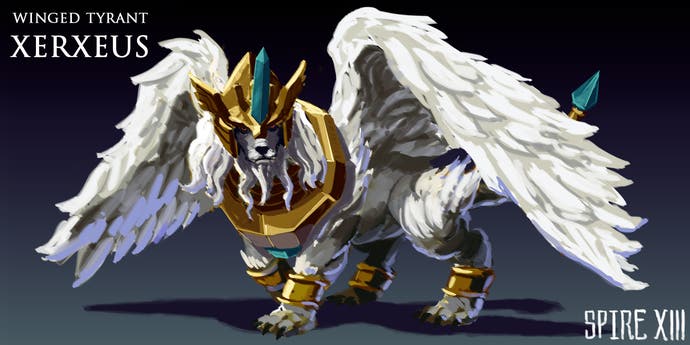
Much of this has come to light "in the past year", Zeth adds - back in 2010, "it was hard to find correct information as a lot of websites liked to host false information or false [interview] translations regarding the Ura Zelda expansion or mixing up beta information for Ura Zelda information. When we started the Ura project, we strived to provide new content in a familiar world, something that would fit into the same quality as Nintendo's work."
Zeth and his collaborators revealed Project Ura in June 2010. It was a dizzyingly ambitious prospect, a marriage of guesswork, reclaimed assets and raw invention. Amongst other things, the announcement doc promised a new protagonist, the Hero of Light, a new fairy partner named Raze, new dungeons, a new overworld, new NPCs, enemies and bosses, new mini-games, an original score and restored Zelda 64 beta materials, all of it running on a tweaked Ocarina of Time game engine.
Zeth posted a series of teaser videos (since pulled offline) plus extracts from the mod's soundtrack. It sounded like paradise on earth to the internet's legions of Ocarina devotees, amongst them CrookedPoe and Walton. CrookedPoe was already familiar with Zeth's mods, and was eager to get involved. "Once the Ura project came to fruition, I knew Zeth's plans for a Hero of Light character, and I offered to import that for him, because I saw that progress wasn't being made, and my speciality was working with the models and characters. I offered to do that, and less than a week later I was brought on board."
Walton, meanwhile, came across a video detailing the Ura Project on the Super Smash Bros forum Smashboards in August 2012 - it included a clip of a brand new area known as the Palace of Ice. "It was kind of what I'd always wanted. Ever since I'd first played Ocarina of Time in 1998, I'd always wanted a dedicated ice area and an ice dungeon, and these modders had essentially been building that. So it completely enticed me."
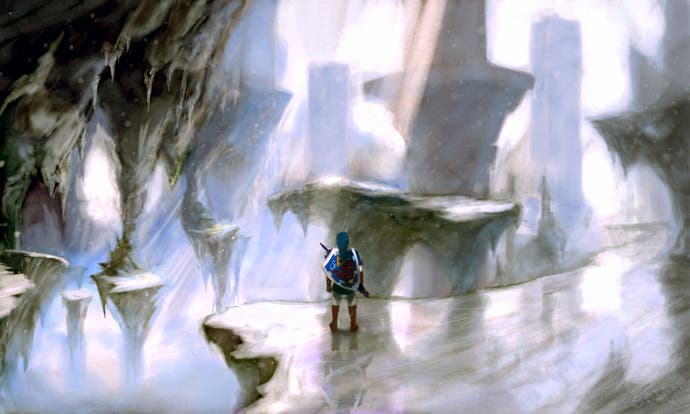
Hooked, Walton sat up one night listening to Project Ura's music on Youtube. "It was composed by somebody named NitroFlasher - his work was absolutely tremendous. It somehow managed to capture the whimsy and mysticality of Koji Kondo's work, while still maintaining an originality. So I listened to the music till dawn, and while doing so I drew a piece of concept art of the Palace of Ice as I interpreted it, and I searched and found the Gamers Collective Network where Ura was kind of stationed, and I posted my digital drawing and went to bed. When I woke up the next day, it had a bunch of replies from the team members asking me to join the team as the concept artist. So that was my entry point."
It was a real adventure. But the honeymoon period proved brief, as the practicalities of producing what was in effect a brand new game took their toll on the Project Ura team - which, at its largest, numbered around 8-10 people, all apparently working in their spare time. Zeth declines to discuss specifics, commenting that there are "a lot of stressful tensions regarding the subject after the project had to be cancelled", but updates posted to the GCN and Zeth's Youtube channel throughout 2012 reveal a group of far-flung enthusiasts struggling in the face of personal setbacks and their own relative inexperience.
Project Ura's programmer Sakura suffered a hardware failure, obliging her to make do with a Linux flashdrive. Zeth had to take time off to recover after being hit by a car. Shadow Fire - a cheerful Australian who specialises in painterly Sonic the Hedgehog mods - was hospitalised after contracting a severe flu.
It's not as if N64 code is easy to work with on a good day - the console is one of the games industry's least developer-friendly machines, a drawback that would become critical in the tussle with Sony for third-party publisher support. "I honestly think any of the N64 Zelda games are the hardest to mod," says Zeth. "Because there are a lot of limitations you have to consider. The game has a 4KB texture memory limitation to work through, for one, on top of rendering only so many polygons at a time. If you make your models with too many polygons, you can lag or even crash your game. Even if you have the expansion pack to add an addition 4MB, if the game isn't programmed to use it, it will stay within the console's normal 4MB limit. I think some of the newer Zelda games are easier, since they use modern techniques which are documented quite well."

“I don't actually have much technical knowledge that really helps,” adds Zeth's associate Shadow Fire by PM of his modding career in general. “Aside from working with hexidecimal, all I've really done is change text in the debug ROM, which was done using a program that was created by someone in the community. Regarding other projects I've worked on, however, I've had to learn Motorola 68k Assembly. There's a lot I'm still trying to learn. Some of the biggest challenges I've faced relate to hardware limitations, or stuff I've yet to learn. One of the lessons I've learned is to ALWAYS make a backup. Time is also a major factor. It's especially difficult to work on a team project when I live in a different timezone.”
With so many obstacles to overcome, a gap inevitably began to form between the grandiose pitch and the project itself. "I kind of assumed [when I joined] that they had built most of the world," Walton recalls. "So I asked: 'Hi Zeth, what's the layout of the world, what's the plan for it, we have a Dark World which is really cool - I love shadowy things. So what's the plan for the Dark World?' And he sent me an MS Paint drawing with some names, and that was it. It was just blobs, roughly representing Hyrule with names inside of them. And I was like 'OK, I guess they just don't have a proper artist, but they maybe have the content'."
One particular source of strife was the decision to change engine. "All of the content that was created had been created with Ocarina of Time in mind," says CrookedPoe. "Then, one day, Zeth just decided that he wanted to do it on the Majora's Mask engine instead, so that would require everybody on the team to redo most of what they have already done with MM in mind, and that made a lot of us very discouraged and demotivated."
If modding Ocarina of Time is difficult, Majora's Mask is, in Walton's words, "a no-man's land". "There just isn't enough documentation on that game. There would need to be years of documentation in order to begin creating a full game conversion. It's too complicated." While Ocarina of Time and Majora's Mask are similar on the surface, the latter game (itself a byproduct of Nintendo's doomed 64DD enterprise, originally titled "Zelda Gaiden") has a number of quirks that make it a nightmare to fiddle with. "Namely, the three-day campaign cycle and the fact that there are all these hard-coded schedules that adhere to different actors - it's really complicated trying to juggle all of that," says Walton.
Project Ura finally became too much for Walton at the turn of 2013. "I started to realise the unfortunate truth that most of the planned world hadn't been constructed yet, so I decided to learn 3D modelling." CrookedPoe had introduced him to Google Sketchup, a free and relatively easy-to-use tool. "I decided to take up the task of learning how to model, because I'd always wanted to, I'd just for years convinced myself that I didn't need to. But Ura finally gave me an excuse to learn 3D modelling. So my first work was very crude, but it was inspiring nonetheless.
"And I had a vision, so I started modelling and I presented my early work to Zeth, saying 'hey man, I know this isn't good enough, but I'm learning to model, could I take on the responsibility of modelling the world?' And he said: 'No, you're not good enough.' And that's when I decided that I was done with Ura." Walton had a "big falling-out" with Zeth, who subsequently banned him from the GCN. "So then I went back to Smashboards, where there was a thread about the Ura project, and I posted a long diatribe - a very angry diatribe out of frustration about how the project was a farce, and then that spread like wildfire, and suddenly it revealed the truth, and that's when Ura fell apart - totally and absolutely died.”
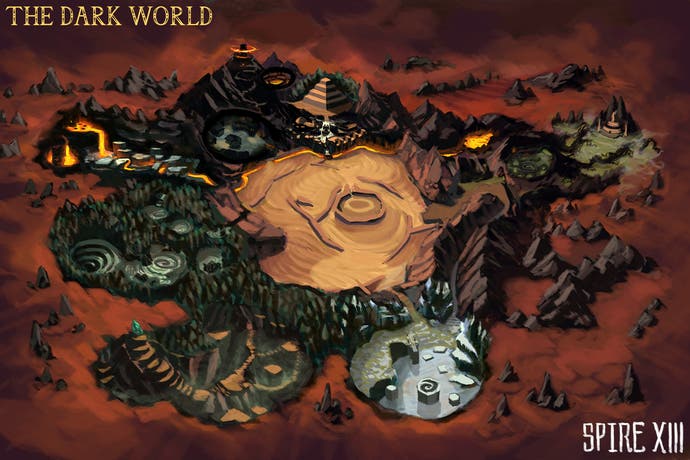
CrookedPoe, too, had become frustrated by how Project Ura was being handled. "I got tired of Zeth - he would send over textures that he wanted put in the game, and I would occasionally take a creative liberty, and suggest ideas I thought were cooler and more appealing, and he would just outright reject any change that I'd made, and if I didn't do exactly what he wanted, it would end up as arguments in the group chat. And I just got tired of it, so eventually I left."
While they have misgivings about his management of the team, CrookedPoe and Walton are grateful to Zeth for his vision and for bringing together so many like minds. "I have very fond memories of the late night talks that Zeth and I would have, just talking about the concept, brainstorming the potential", reflects Walton, adding later in our chat that Zeth "was integral to the meeting of so many people, and the Ura Project kind of paved that road. Somehow, it built up enough hype that a lot of people came together, like CrookedPoe and I - I wouldn't ever have been part of the Zelda modding scene if not for the Ura project. So for that and to Zeth I am thankful."
There are still modders out there trying to revive Ura - or at least, give a concrete form to what Ura might have been. One is Project Beta: Triforce, whose creator hopes to introduce four new dungeons and a number of mini-dungeons. Zeth also has things on the boil, though he refrains from sharing details. "I do have a project currently in the works that Shadow Fire and a couple of members from the old Ura team are working on, which is a successor to that project. However, that's about all I can say regarding it for now."
CrookedPoe is hopeful that his career as a Zelda modder will help him make headway in professional software development. "These two games [Ocarina of Time and Majora's Mask] are what I owe my interest in computer science and mathematics to," he says. "And eventually maybe I can hope to secure a position, whether it be in game development or some other technology-related profession - till then I'm just going to have to search for whatever I can to get employed."

In the meantime, he and Walton are working on a long-term "research and development project" that may or may not be set in the Zelda universe. "It's a very beautiful collaboration," says Walton. "And we're able to just express ourselves within that framework, and hopefully what we learn from it we can one day apply to something independent, something totally original."
You could look at a concept like Ura Zelda, larger in "death" than it perhaps ever was in "life", and feel a certain horror - about our ability to lose ourselves in our own delusions, our readiness to elevate a sumptuous myth above a mundane truth. There's a touch of the melancholy ephemerality of my favourite Zelda game, Link's Awakening, to how what was ultimately nothing grander than a remixed campaign has spawned a comet's tail of fantasies, representations chasing representations through the ether.
Or you could look at the reverence and delight that surrounds these fantasies, however dubious their relation to the original project, and celebrate art's ability to transcend its circumstances, flourishing as it transmits itself from mind to mind. It's a quality Walton identifies in the work of Prince and David Bowie, two of his biggest inspirations. "They left the world with symbols - Prince gave us the love symbol, and Bowie gave us the black star, and those symbols are eternal, and continue to ask questions about the heart, the mind and the soul.
“And Zelda is riddled with symbols, these bizarre, mysterious, archaic symbols that are created by people for fiction, but that end up resonating with us - like the Triforce, like Majora's Mask, like the symbols for the different medallions, and the three symbols of the goddesses. Why do we remember them? Why do they stick with us? It's because they represent something intrinsically human, and therefore they emanate eternal truth."
Zeth has responded to some of the observations from other Project Ura members in this piece - read his thoughts in the comments thread below, or check out the initial comment here. Thanks to Ben Walton for the concept artworks above - you can find more on his blog - and to Zeth for the screenshots of his many Ocarina of Time mods.
